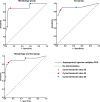Validation of a new Aspergillus real-time PCR assay for direct detection of Aspergillus and azole resistance of Aspergillus fumigatus on bronchoalveolar lavage fluid
- PMID: 25568431
- PMCID: PMC4390672
- DOI: 10.1128/JCM.03216-14
Validation of a new Aspergillus real-time PCR assay for direct detection of Aspergillus and azole resistance of Aspergillus fumigatus on bronchoalveolar lavage fluid
Abstract
Azole resistance in Aspergillus fumigatus is increasingly reported. Here, we describe the validation of the AsperGenius, a new multiplex real-time PCR assay consisting of two multiplex real-time PCRs, one that identifies the clinically relevant Aspergillus species, and one that detects the TR34, L98H, T289A, and Y121F mutations in CYP51A and differentiates susceptible from resistant A. fumigatus strains. The diagnostic performance of the AsperGenius assay was tested on 37 bronchoalveolar lavage (BAL) fluid samples from hematology patients and 40 BAL fluid samples from intensive care unit (ICU) patients using a BAL fluid galactomannan level of ≥1.0 or positive culture as the gold standard for detecting the presence of Aspergillus. In the hematology and ICU groups combined, there were 22 BAL fluid samples from patients with invasive aspergillosis (IA) (2 proven, 9 probable, and 11 nonclassifiable). Nineteen of the 22 BAL fluid samples were positive, according to the gold standard. The optimal cycle threshold value for the presence of Aspergillus was <36. Sixteen of the 19 BAL fluid samples had a positive PCR (2 Aspergillus species and 14 A. fumigatus samples). This resulted in a sensitivity, specificity, and positive and negative predictive values of 88.9%, 89.3%, 72.7%, and 96.2%, respectively, for the hematology group and 80.0%, 93.3%, 80.0%, and 93.3%, respectively, in the ICU group. The CYP51A real-time PCR confirmed 12 wild-type and 2 resistant strains (1 TR34-L98H and 1 TR46-Y121F-T289A mutant). Voriconazole therapy failed for both patients. The AsperGenius multiplex real-time PCR assay allows for sensitive and fast detection of Aspergillus species directly from BAL fluid samples. More importantly, this assay detects and differentiates wild-type from resistant strains, even if BAL fluid cultures remain negative.
Copyright © 2015, American Society for Microbiology. All Rights Reserved.
Figures
References
-
- Walsh TJ, Anaissie EJ, Denning DW, Herbrecht R, Kontoyiannis DP, Marr KA, Morrison VA, Segal BH, Steinbach WJ, Stevens DA, van Burik JA, Wingard JR, Patterson TF, Infectious Diseases Society of America . 2008. Treatment of aspergillosis: clinical practice guidelines of the Infectious Diseases Society of America. Clin Infect Dis 46:327–360. doi:10.1086/525258. - DOI - PubMed
-
- Slobbe L, Polinder S, Doorduijn JK, Lugtenburg PJ, el Barzouhi A, Steyerberg EW, Rijnders BJ. 2008. Outcome and medical costs of patients with invasive aspergillosis and acute myelogenous leukemia-myelodysplastic syndrome treated with intensive chemotherapy: an observational study. Clin Infect Dis 47:1507–1512. doi:10.1086/591531. - DOI - PubMed
-
- Herbrecht R, Denning DW, Patterson TF, Bennett JE, Greene RE, Oestmann JW, Kern WV, Marr KA, Ribaud P, Lortholary O, Sylvester R, Rubin RH, Wingard JR, Stark P, Durand C, Caillot D, Thiel E, Chandrasekar PH, Hodges MR, Schlamm HT, Troke PF, de Pauw B, Invasive Fungal Infections Group of the European Organisation for Research and Treatment of Cancer and the Global Aspergillus Study Group . 2002. Voriconazole versus amphotericin B for primary therapy of invasive aspergillosis. N Engl J Med 347:408–415. doi:10.1056/NEJMoa020191. - DOI - PubMed
Publication types
MeSH terms
Substances
LinkOut - more resources
Full Text Sources
Medical


